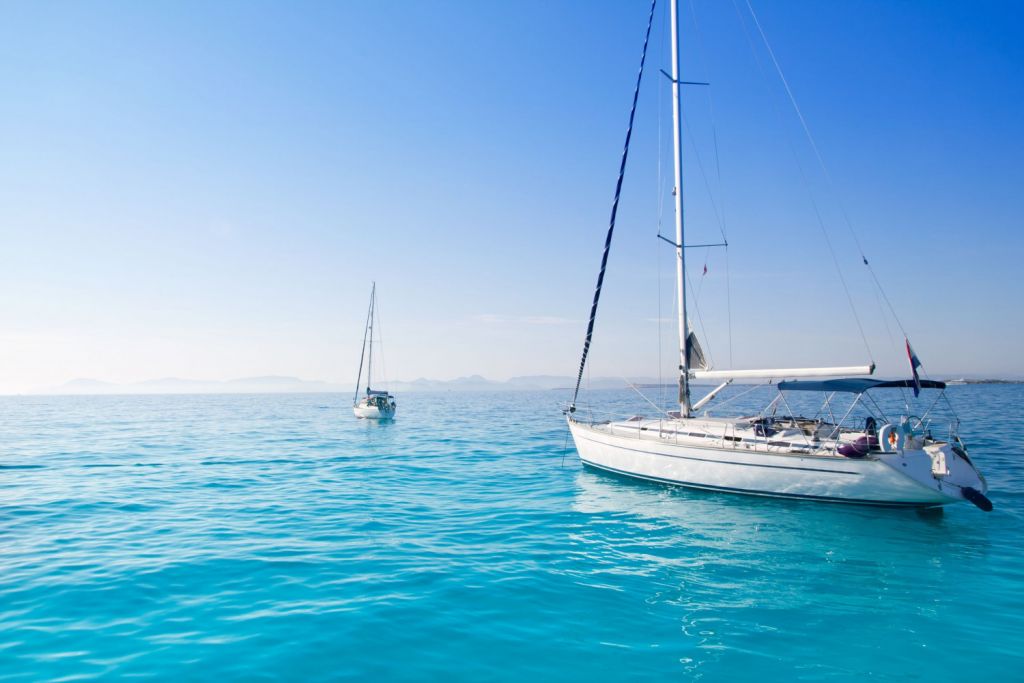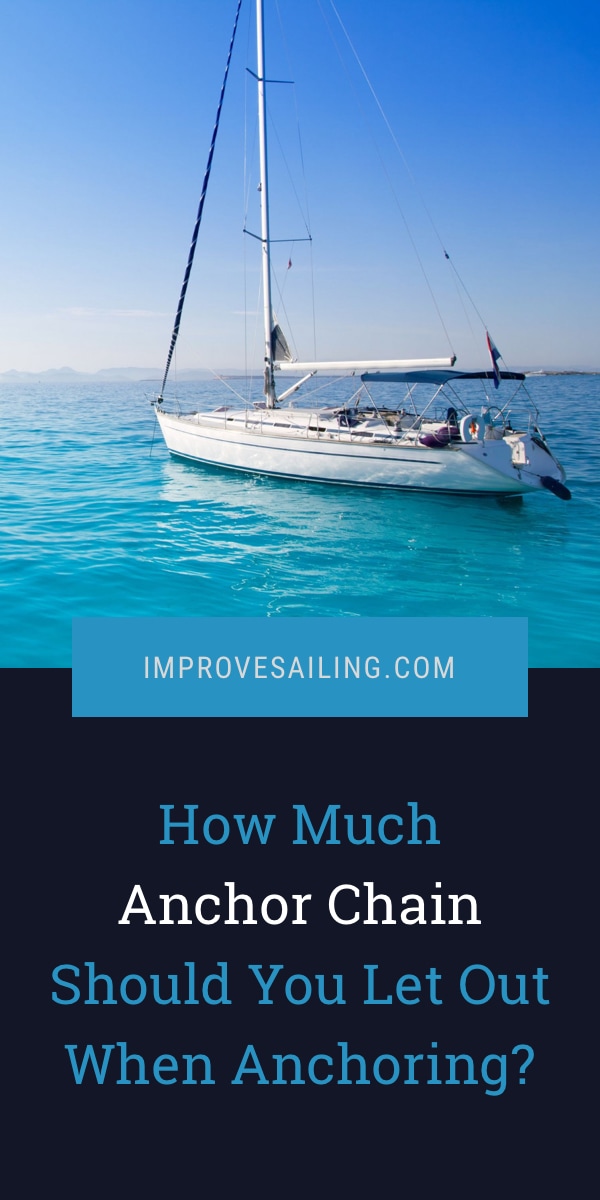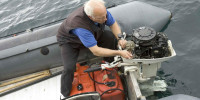How Much Anchor Chain Should You Let Out When Anchoring?
Setting out the right amount of anchor chain is an important part of getting a good night’s sleep on your boat. The scope of your anchor chain – the ratio of chain to the complete anchoring depth – is the key factor in your boat being where you left it when you come back. Figuring the scope is a skill like any other you need to master, but the basics are not complex.
How much chain should you let out when anchoring? In most conditions with an all chain rode, for a secure overnight anchorage you will need to let out four to five times the total of the depth at high tide plus the height of the anchor roller from the water to get the correct scope. For a “lunch hook” - anchoring for a limited time when the boat will not be unattended - a three to one ratio is suitable.
This is right for most conditions, but it doesn’t cover every condition. Crowding in an anchorage, local regulations and expected weather all can affect the final decision on just how much chain you need to let out.

On this page:
The Length of Anchor Chain for Different Conditions
The scope is the ratio of chain to the complete anchoring depth. So what ratio should you use?
- Typically: 4 to 5 times the complete anchoring depth
- Lunch hook: 3 times the complete anchoring depth
- Bad weather: 5 to 7 times the complete anchoring depth
Use a smaller scope when the anchorage is crowded or has restricted space.
The complete anchoring depth is the total depth at high tide + the height of the anchor roller from the waterline.
Calculating Complete Anchoring Depth
The toughest part of word problems in math class was getting the right formula on paper. This isn’t an algebra class, so I can just give you the formulas. Your target anchoring depth, expressed as a formula, should be:
Complete Anchoring Depth = Current Depth + Depth Increase to High Tide + Height of Anchor Roller
Calculating Depth Increase to High Tide
The Depth Increase to High Tide can be a little more complex, but you will get good at estimating it with time and a conservative estimate is sufficient.
Depth Increase to High Tide = (Hours From High Tide / Length Between Tides) * Tidal Swing
- From a tide table, take the height of the highest tide and subtract the height of the lowest tide. This will give you the “swing” of the tide for the day.
- Estimate how many hours between high and low tides, and how many hours you are from the last or next high, whichever is closer.
- The time from the nearest high divided by the time between tides tells you how far you are into the tide change.
- You can multiply that by the tidal swing to estimate how much the tide will rise while you are at anchor.
EXPERT TIP: If you can see exposed pilings or rocks on land when you are anchoring, the marine growth showing on them is a quick way to estimate how much the tide will come in without a tide table or doing any math! Just make sure you’re looking at a rock that the high tide won’t completely cover.
If you anchor in twenty feet of water at low tide, the tide will come in five feet at high tide, and your bow roller is four feet from the water the calculation is 20 (depth) + 5 (tide) + 4 (bow height) = 29. Multiplying by four or five give a range from 116 to 145 feet of chain required for a secure anchor.
Anchor Chain Mistakes
Many boaters overlook key pieces of information when figuring how much scope they need to anchor securely.
One common mistake is to use the current depth of the water beneath the boat at the time they drop the anchor.
Another mistake is not including the height of the anchor roller above the water. Forgetting either of those factors will leave you without enough chain for comfort and safety.
One other error boaters make is not measuring how much chain they have put out. Chain racing out of the anchor locker is tough to estimate by eye, and it’s easy to assume you’ve let out more or less than you have. Getting the math right but the measurements wrong isn’t safe either.
Some method of knowing how much chain you have down is critical. You can install a mechanical or electronic chain counter, or you can mark your chain to show distances as it goes out. Most chain markers wear off or fade, so pick a method as close to permanent as you can.
Why You Need This Much
With an all chain rode, most of the holding power is in the chain's weight.
The anchor keeps the chain from dragging, but the primary pull holding the boat is the weight and friction of the chain against the bottom. Most of the load of the boat is resting on the chain, and the boat should not pull directly on the anchor. It will not hold.
If there is insufficient chain, and the boat is pulling on the anchor, the anchor may not lie flat on the bottom preventing the flukes and plows from settling into the bottom as designed.
Also, if the boat swings and the heading changes with wind or tide and there isn’t enough chain to let the anchor lie flat, it may not reset properly when the load changes direction. Enough scope may keep the anchor from resetting if the wind direction changes.
You can’t ignore the tide in areas with larger tidal swings. We’ve experienced tidal swings up to sixteen feet in some of the places we’ve traveled. At a 5:1 scope, you’d be up to eighty feet short of the required chain if you did not include this. Even a three foot tide can leave you up short in shallow water.
When You Might Need or Want Less
There are conditions which call for less chain.
In crowded anchorages
In crowded anchorages with a lot of boats you may not have space to let out more chain without hitting other boats. In a crowd it’s okay to ask another skipper how much rode they have out. You need to estimate how big of a circle your boat will make if the wind swings through the compass, and how you will lie with the other boats. If you anchor around several boats with rope/chain rodes and you are all chain, your swing will differ from those around you. You may wish to shorten the chain to stay out of their larger swing radius.
Anchorages with restricted space
Anchorages with restricted space may require you to stay within buoyed off areas and keep your scope short despite all the open space nearby. One harbor we anchored in had a small wedge-shaped anchorage designated on the charts, and a mooring field that encroached into the designated anchorage. The local navy enforced the zone aggressively and would move you if you swung over a line marked by pilings. We perched on the edge of the mooring field with a three-to-one scope so we wouldn’t swing into the moored boats in a southerly or the prohibited zone in a northerly.
Lunch Hook
And if you are not staying long in a spot you need not hunker down like you’re expecting a blow, especially if you have a manual windlass and have to haul all that chain back on board after lunch and a quick swim! If conditions are mild and you are not planning to leave your boat or sleep on it, it’s easier to set a shorter scope.
Use More Chain in Adverse Conditions
A change in the weather, especially a change for the worse, may require more chain than calculated. As long as there is swinging room with other boats around you, there is no harm in taking your scope out for six or seven to one. A change in wind direction, tidal current, or a large increase in wind strength all call for letting out a little more chain. A forty-knot blow will straighten your chain and pull a lot more off the bottom; more scope will prevent that.
Checking the weather for your anchorage is as important as checking it for your trip out there. Sudden shifts in wind direction can unseat an anchor as the boat swings and the anchor loads up. Comfort is a consideration when you choose your anchoring spot, and a wind shift in the night might make a cozy anchorage uncomfortable. But not having enough scope out to hold you when that happens takes it from uncomfortable to dangerous.
Related Questions
How long of anchor chain do you need? It depends on where you plan to cruise with your boat. If you spend your time in shallower waters with small tidal swings such as the Chesapeake your needs will differ from someone in the deep waters of Maine. Estimate the deepest place you may anchor, add in a fudge factor, and use the formulas.
Is the amount to let out the same for a rope/chain anchor rode? The formula for anchoring depth is the same, but the ratio is higher. For a rope/chain combination rode your scope should be as close to 7:1 as you can get, but no less than 5:1
Did you find the answer to your specific question?
👍 21 👎 4




Comments
Mathias
As somebody who is living on a boat and being dependent on everybody around me not making stupid decisions, I find this topic cannot be covered enough! However, a comment: “The anchor keeps the chain from dragging, but the primary pull holding the boat is the weight and friction of the chain against the bottom.” I am afraid that is simply wrong. If that were true, it would be the frictional force of the chain on the seabed that is holding us, and thinking further, soon the question would arise why would we need an anchor in the first place? It is the anchor that is holding the boat - fully. The chain is a means to redirect the angle of pulling force from the bow, were it has a large vertical component, to something that is mostly horizontal, and hence will not pull out the anchor. This is what the catenary does. What is needed for this is a long enough chain, and the thicker it is the shorter it may be. See my analysis at https://trimaran-san.de/die-kettenkurve-oder-wie-ein-mathematiker-ankert/ - apps incl.
William Porter
Interesting observation and discussion, but I did make it clear it was the “primary” force, not only force.
In scenarios with more wind or wind shifts strong enough to move the chain, the anchor is a crucial bit to keep things in place.
In light wind situations, you can clearly see the boat drifting around over the chain, not the anchor. There, the chain lying on the bottom is enough to keep the boat in place.
With more wind, of course the math changes and gets much more complex, as your link describes.
But I note you state “I ignore friction and any form of energy dissipation” in the calculations. When determining drag resistance of a rode/anchor combination, I think you are overlooking a significant force. Chain stretched out on a seabed (or in the mud) offers considerable resistance from friction, until it is pulled off the bottom it helps hold the boat.
Whether that is significant relative to the dragging force from the boat in a variety of conditions needs to answered.
Mathias
Ignoring friction and energy dissipation is certainly on the conservative side, but friction is by no means an important factor when it really matters. When it blows hard, all or most of the chain will be off the ground, so that friction is gone. And sure, when there is less wind, some chain will rest on the seabed and help the anchor by means of friction. But: A) It is not a lot, since it is only the weight of the chain on the seabed (at best), which is usually a small force compared to what the anchor can deal with and B), I do not care about this contribution, as it is only relevant when it does not blow hard, and so I have a lot of safety margin in the anchor, anyway. The friction of the chain slashing through the water is always there (as the vessel moves back and forth), true, but one can estimate that contribution and it turns out not be be too big a factor in the overall picture. So, one can safely ignore it and keep it as a small safety margin.
Mathias
I have now created a free anchor chain calculator that may help some to get more confident when anchoring. It is based on a simplified physical model and has proven quite reliable for me: www.anchorchaincalculator.com
ReaderX
Thanks for adding to the discussion, Mattias. I was surprised the author made no mention of anchor weight being a factor. People pay good money for heavier anchors for a reason. Also, there was no mention of rough hints on double anchoring.
Overall, the original guide to chain length was handy, as intended. However, it could use an update to cover a little more clarity on these unaddressed aspects to more fully inform readers. Just add some “Advanced Topics” subsection to the article.
Polly Marcus
An interesting topic and I’m glad to come across your page where I found some helpful insights. Check out my website <a href=”http://legacy.creators.com/redirect.php?link_id=2377&link_url=http://article-home.com/">Article Home</a> too, if you need additional resources about SEO.
Leave a comment